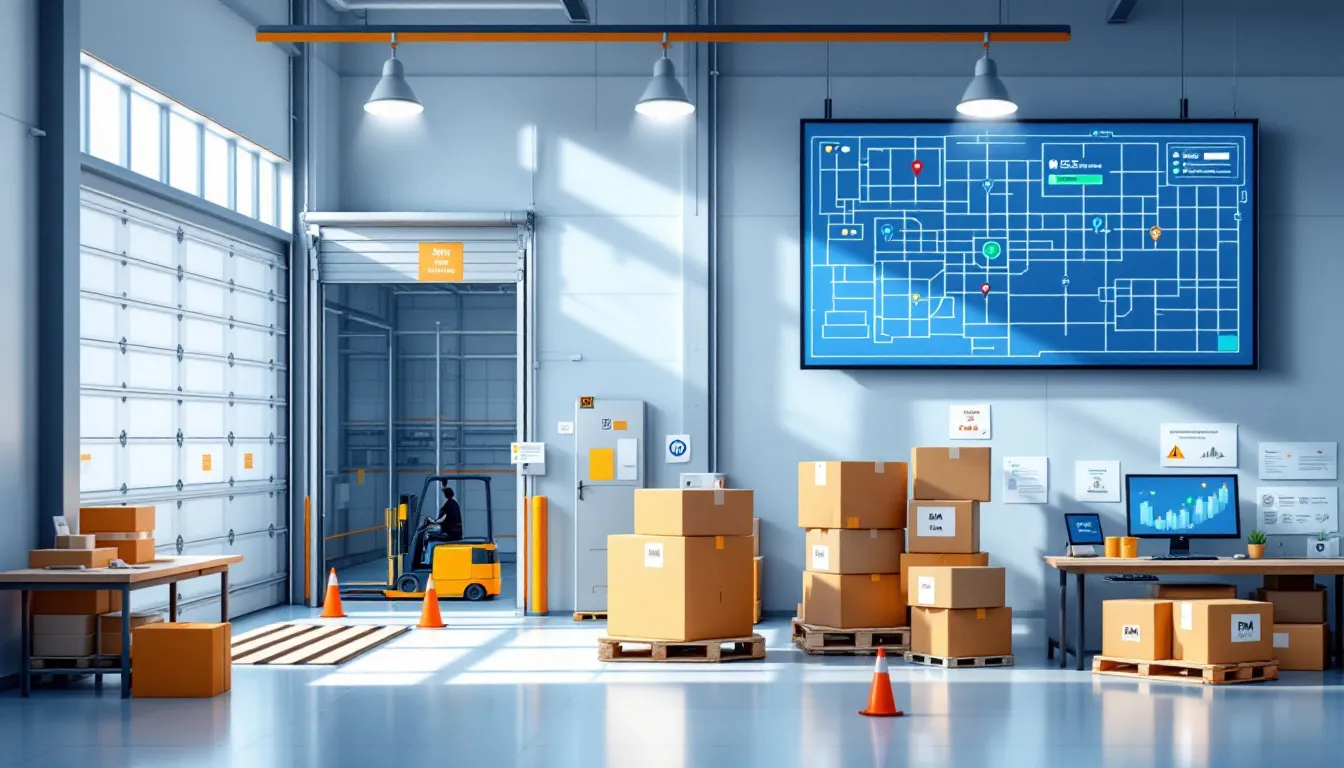The concept of inbound and outbound logistics involves the efficient movement of goods into and out of a warehouse. The inbound process includes receiving, quality control, and storage of goods. The outbound process covers picking, packing, and shipping products to customers. This article explores best practices and strategies to optimize these processes, ensuring operational efficiency and customer loyalty through improved warehouse performance and streamlined ecommerce supply chain management.
Key Takeaways
- Optimizing inbound and outbound logistics processes is crucial for improving supply chain efficiency, reducing costs, and enhancing customer satisfaction.
- Key strategies for outbound logistics and inbound processes include leveraging technology, establishing strong supplier relationships, and implementing continuous improvement practices to streamline operations.
- Effective stock control and coordination are vital for addressing challenges in logistics and ensuring that goods are accurately tracked and delivered on time.
Understanding Warehouse Inbound Process

The inbound process refers to all the steps involved when goods enter the warehouse. These steps ensure that products are received accurately, meet quality standards, and are stored correctly.
Key steps in the inbound process include:
- Receiving: Goods are unloaded, checked against purchase orders, and documented.
- Inspection & Quality Control: Items are inspected for damage, quantity discrepancies, or defects.
- Labeling: Each item is labeled for tracking, often using barcodes or RFID tags.
- Putaway & Storage: Goods are moved to assigned storage locations based on item type or demand frequency.
From placing orders to receiving goods, conducting quality control, and managing storage, each step is crucial for maintaining a efficient supply chain. Effective inbound logistics relies on reliable transportation, reduced raw materials costs, and optimal inventory levels – a key factor in successful distribution management.
Both inbound and outbound logistics involve several key activities that ensure the smooth flow of goods into the warehouse. These activities include receiving goods, quality control inspections, and storage management. Each of these steps plays a vital role in maintaining inventory accuracy and ensuring that goods are available when needed, thereby supporting the overall efficiency.
Efficient inbound logistics not only enhance operational workflows but also improve product availability, reduce bottlenecks, and support a seamless first mile delivery. Optimizing these processes can lead to significant cost savings and a stronger competitive edge.
Receiving Goods
This is the first critical step in the inbound logistics process. It involves unloading shipments, checking them against purchase orders, and conducting initial inspections to ensure accuracy. During this stage, it’s vital to document items using proper shipping documentation such as a waybill to avoid discrepancies and ensure transparency. This step is crucial in inbound logistics because any discrepancies at this stage can lead to significant issues down the line.
In supply chain management, it’s essential to count the contents and verify them against the order to ensure that the correct items have been delivered in the right quantities. This verification process helps in managing inventory levels accurately and prevents stockouts or overstocking issues. Initial inspections also play a crucial role in quality control, ensuring that the received goods meet the required standards before they are stored.
Effective management of the receiving process and automated warehouse picking systems not only ensure accurate inventory management but also contributes to timely order fulfillment. Prioritizing accuracy and efficiency during this stage sets the tone for the entire warehouse operation, ensuring a smooth flow of goods through the supply chain.
Quality Control
Quality control in both inbound logistics and outbound logistics processes ensures that incoming goods meet the required standards before they are stored. This process typically involves checking goods at the supplier’s warehouse before they leave, as well as conducting inspections upon arrival at the distribution center. The quality department provides specific instructions for sampling, inspecting, and rejecting failed samples, ensuring that only high-quality products enter the warehouse.
A robust quality control process ensures that only top-tier goods are stored and shipped. This includes detailed inspections upon arrival and supplier-side checks. Businesses handling regulated products – such as those that sell supplements or health items – must follow strict quality protocols to stay compliant and uphold brand reputation. Quality assurance also impacts customer satisfaction. Identifying issues early in the inbound process helps avoid costly returns or reverse logistics downstream.
Storage and Putaway
Once goods have passed the quality control inspections, they are moved to storage. Implementing vertical storage solutions, such as shelving and stacking systems, can significantly enhance the capacity of the storage area, making the most of the available space for warehouse staff.
Organizing goods by categories or frequency of use ensures that the most accessible items are located in designated storage locations. This strategy not only streamlines the putaway process but also leads to faster order fulfillment and reduced space wastage. Effective storage is essential for preventing split shipments, which can increase shipping costs and lower customer satisfaction. It also helps to ensure that goods are readily available when needed, especially as part of an efficient inbound logistics strategy.
Key Elements of Warehouse Outbound Process

Outbound logistics refers to the processes involved in distributing finished products to customers, including picking, packaging, shipping, and order fulfillment. The main goal of outbound logistics focuses is to ensure that products reach customers promptly and in proper condition, which significantly impacts customer happiness. Efficient outbound logistics processes inbound play a crucial role in enhancing delivery speed and overall customer experience.
Transporting orders from a warehouse to the end customer is essential to ensure timely delivery and customer retention. High-performing outbound operations depend on seamless coordination between -teams, accurate documentation, and technology-backed fulfillment – especially in models like TikTok fulfillment, where speed and visibility are critical.
The outbound process starts when a customer places an order and ends when the product leaves the warehouse.
Key steps in the outbound process include:
- Order Picking: Items are retrieved from storage based on the customer order.
- Packing: Products are securely packed with protective materials and labeled.
- Shipping: Packages are handed off to carriers or delivery drivers with the correct documentation.
Effective management of the outbound logistics process not only ensures timely and accurate delivery but also contributes to a positive customer experience, fostering loyalty and repeat business. Let us now consider each step of outbound process for efficient supply chain management.
Order Picking
Order picking is a critical process in warehouse management that determines how quickly and accurately orders are fulfilled. One effective for outbound logistics method is batch picking, which allows workers to pick multiple orders simultaneously, significantly enhancing throughput and reducing the time taken to fulfill orders. By implementing efficient picking methods like batch picking, businesses can streamline their operations in the warehouse and improve coordination between inbound logistics and outbound tasks.
Efficient order picking is essential for maintaining high levels of customer service and for complementing well-structured inbound and outbound operations. Optimizing the picking process ensures customer orders are processed quickly and accurately, resulting in timely deliveries and enhanced customer experience. It also plays a pivotal role in optimizing multi-echelon inventory, as picking accuracy directly affects inventory visibility across fulfillment nodes.
Packing
This is a crucial step in the outbound logistics processes, as it ensures that goods are secure and ready for transportation. Using proper cushioning materials during packing can protect items from damage during transit, ensuring that they arrive in excellent condition. Effective packing not only safeguards the products but also enhances customer experience by ensuring that orders are delivered intact.
The packing process involves several steps, including selecting the appropriate materials, packing the items securely, and labeling the packages for identification and tracking. Streamlining the packing process reduces shipping costs and minimizes transit damage risk, ultimately enhancing customer loyalty.
Outbound logistics processes also benefit from standardizing packing methods to ensure consistency and reduce handling time. This helps warehouse staff maintain speed without compromising accuracy and minimizing errors.
Shipping
Shipping the goods is the final step in the outbound logistics process and involves several critical activities to ensure timely and accurate delivery.
These activities involved include:
- Packing products in boxes or poly mailers
- Labeling packages with shipping details to ensure readiness for transportation
- Handing over orders to delivery drivers or loading them onto trucks for shipment.
This process is essential for maintaining efficiency in outbound logistics and satisfaction of clients.
Accurate documentation is essential during the shipping process to track shipments and resolve any delivery issues that may arise. Proper labeling and identification of shipments also play a crucial role in ensuring that orders are delivered to the correct destinations. Enhancing the shipping process improves overall outbound logistics operations and ensures timely deliveries.
Efficient shipping not only enhances customer experience, but also contributes to better inventory management and reduced operational costs. By optimizing the shipping process, businesses can achieve significant improvements in their inbound and outbound logistics deals and overall efficiency.
Challenges in Warehouse Inbound and Outbound Logistics

Managing inbound and outbound logistics comes with a unique set of challenges. These can affect operational efficiency, increase costs, and impact customer satisfaction if not addressed proactively.
Common Inbound Logistics Challenges:
- Transportation Delays: Late deliveries from suppliers disrupt warehouse schedules.
- Inaccurate Shipments: Mismatches between orders and received goods can lead to inventory issues.
- Quality Control Failures: Damaged or non-compliant items increase processing time and waste.
- Poor Inventory Visibility: Without real-time tracking, it’s harder to plan storage or replenishment accurately.
- Limited Storage Capacity: Space constraints lead to inefficiencies in putaway and order picking.
Common Outbound Logistics Challenges:
- Order Picking Errors: Mistakes during picking can delay shipments and frustrate customers.
- Packing Inconsistencies: Poor packaging increases the risk of damaged goods during transit.
- Inefficient Shipping Coordination: Missed pickups or routing issues slow down delivery.
- Costly Returns (Reverse Logistics): Handling returns adds extra complexity and can drain resources.
- Lack of Real-Time Tracking: Reduces visibility and delays communication with customers.
Synchronizing inbound and outbound logistics can lead to significant cost savings and improved delivery times. Harmonizing these processes reduces operational costs and enhances service quality, leading to better overall supply chain.
By addressing some of the most common challenges in inbound and outbound logistics, businesses can improve their operations and achieve a competitive edge in the market. Let’s consider some of them, as well as discuss ways to overcome these hurdles in supply chain management.
Inventory Management Issues
Inventory management is important, but it comes with its own set of challenges. Maintaining inventory accuracy is needed for smooth operations of inbound and outbound logistics and customer happiness, but factors like procurement errors and unpredictable lead times can complicate stock levels. External suppliers and lack of proper checks during inventory receiving can also lead to inaccuracies. Accurate inventory levels also serve as a benchmark for evaluating the performance of inbound logistics, highlighting areas for potential improvement.
Optimizing inventory management involves better demand forecasting and calculating optimal reorder points. Effective cost management is crucial, as inventory represents a significant expense for businesses. Maintaining inventory accuracy and optimizing how to manage inventory reduces operational costs and improves overall efficiency.
Coordination and Communication
Effective coordination and communication are essential for building strong supply chain partnerships and ensuring efficient delivery. Strong relationships in inbound logistics and outbound logistics improve collaboration, reduce lead times, save money, reduce lead times, save money, and secure better contract terms. For example, consistently paying vendors on time and being respectful can form long-term partnerships in logistics, which are crucial for successful operations.
Respectful communication and prompt handling of customer issues are also necessary for maintaining good relationships in outbound logistics. Sharing real-time data upstream and downstream allows inbound logistics partners to anticipate demand changes and adjust accordingly.
Effective coordination and communication improve inbound and outbound logistics operations and enhance efficiency, leading to efficient logistics.
Cost Management
Cost management is a significant challenge in logistics, as high costs can be incurred if inbound and outbound logistics are not optimized. Well-managed logistics can save money for businesses by enhancing operational efficiency and competitiveness. Regular evaluations and adjustments of logistics processes are essential for maintaining efficiency and reducing operational costs.
Inventory accounts for a significant portion of logistics spending, highlighting the need for cost-effective inbound logistics management strategies. Achieving high inventory accuracy minimizes stock discrepancies and reduces operational costs. Effective cost management optimizes logistics operations, including inbound logistics, and results in significant cost savings, ultimately impacting inventory costs.
A complex supply chain management system can create difficulties in finding cost-effective logistics solutions, making it crucial to streamline processes and enhance communication. Ordering too much inventory can incur high inventory carrying costs, so businesses must focus on optimizing inventory levels to reduce costs. By addressing these challenges, businesses can improve their outbound logistics processes and achieve better overall efficiency.
Pros and Cons of Efficient Warehouse Inbound and Outbound Logistics
Optimizing these processes brings significant benefits, but also requires thoughtful planning and resource allocation.
Pros:
- Improved Inventory Accuracy: Fewer discrepancies lead to better forecasting and stock control.
- Faster Order Fulfillment: Streamlined operations reduce delays and improve customer satisfaction.
- Lower Operational Costs: Efficient handling reduces waste, labor costs, and shipping errors.
- Better Supplier & Customer Relationships: Reliable performance builds long-term trust on both ends of the supply chain.
- Scalable Processes: Easier to adapt to growth without major disruptions.
Cons:
- High Initial Investment: Implementing WMS systems and automation tools can be expensive upfront.
- Training Requirements: Staff may need time to adapt to new processes or technologies.
- Complex Coordination: Synchronizing inbound and outbound operations takes planning and real-time communication.
- Risk of Over-Automation: Without human oversight, automated systems can create cascading errors if something goes wrong.
Best Practices for Optimizing Inbound Logistics

Improving inbound logistics can lead to faster movement of goods, which directly contributes to increased revenue. Efficiently managing inbound and outbound logistics is crucial for maintaining a competitive edge, leading to cost savings and enhanced operational efficiency. To optimize inbound logistics, improving efficiency and reducing costs can be achieved by addressing challenges in logistics. This also helps maintain high standards of customer service.
Collaborative planning facilitates better demand forecasting and inventory management between suppliers and distributors. Engaging in collaborative planning reduces inventory levels by enabling accurate forecasts between manufacturers and retailers. By implementing these best practices, businesses can optimize their inbound logistics and achieve better overall efficiency.
Leveraging Technology
Modern tools can transform a variety of outbound logistics processes. Key technologies include:
- Warehouse Management Systems (WMS): Automate order processing, manage inventory in real-time, and streamline receiving tasks.
- Logistics Management Systems (LMS): Improve visibility into supplier shipments and coordinate inbound transportation more effectively.
- Barcode scanning & RFID tracking: Improve accuracy during receiving and putaway processes.
- Real-time dashboards: Help monitor inbound performance and catch issues early.
Tip: Choose systems that integrate easily with your existing ERP and scale with your business.
Supplier Relationships
Smooth inbound logistics start well before the goods arrive. Build strong supplier partnerships by:
- Maintaining open, transparent communication
- Sharing demand forecasts regularly
- Collaborating on delivery schedules and lead time improvements
- Resolving issues quickly and respectfully
When suppliers trust your process, they’re more likely to deliver on time and with fewer errors—improving the reliability of your entire supply chain.
Continuous Improvement
Implementing warehouse management systems (WMS) can significantly enhance operational efficiencies, enabling continual inbound logistics process evaluations and adjustments. Establishing strong relationships with suppliers allows for better communication and feedback, which can lead to improvements in delivery schedules and quality control.
Effective cost management strategies are crucial for identifying areas that require improvement, leading to optimized processes and reduced operational expenses. Utilizing key performance indicators (KPIs) such as on-time delivery rates, inventory accuracy, and order fulfillment accuracy can help track performance and guide continuous improvement efforts in inbound logistics and risk management.
Strategies for Enhancing Outbound Logistics

Enhancing outbound logistics involves implementing strategies that improve the efficiency and accuracy of order fulfillment. Shipping in logistics includes selecting transportation modes and scheduling carriers to ensure timely deliveries. Partnering with a 3PL can provide better carrier relationships for shipping discounts and more frequent order dispatch.
Monitoring delivery performance is essential, as timely shipping directly impacts customer experience. On-time delivery rates indicate how many shipments arrive at their destination within the scheduled timeframe.
By focusing on these strategies, businesses can improve their outbound logistics operations and help business achieve success with better overall efficiency in their supply chain management.
Automation in Outbound Processes
Automating warehouse functions leads to increased efficiency and higher accuracy rates, making it a crucial strategy for enhancing outbound logistics. WAPI’s Warehouse Management System (WMS) reduces picking errors, manages inventory in real-time, and fulfills orders faster. Tasks that can be automated in operations include processing orders, generating pick lists, and invoicing.
Warehouse automations, barcode scanning, and a dashboard for real-time visibility help streamline inventory management, leading to better overall efficiency. By focusing on automation, businesses can enhance their outbound logistics operations and improve customer loyalty.
Real-Time Tracking
Utilizing real-time tracking systems can significantly improve customer communication and transparency, leading to better efficiency. Implementing real-time tracking systems enhances visibility in the supply chain and boosts customer communication, ensuring timely deliveries and improved customer experience.
Access to live tracking information can significantly improve the relationship between logistics providers and their customers, leading to better overall service and customer retention.
Customer-Centric Approaches
Aligning logistics operations with customer needs can enhance loyalty and satisfaction, making it a crucial strategy for enhancing outbound logistics. Proactive communication regarding delivery issues can significantly improve customer trust in logistics, leading to better overall customer satisfaction.
Efficient problem handling in outbound logistics is vital for maintaining customer trust, as it ensures that orders are fulfilled accurately and in a timely manner. High on-time delivery rates lead to improved customer loyalty and repeat business, making it essential for businesses to focus on customer-centric approaches.
Monitoring order fulfillment accuracy is crucial for ensuring that customers receive the correct items in the promised timeframe, contributing to higher customer loyalty. Customer-centric approaches improve outbound logistics and enhance overall processes.
The Role of Reverse Logistics in Warehouse Operations
Reverse logistics refers to the process of handling customer returns and exchanges, facilitating the movement of goods back to manufacturers. This process encompasses various activities, including product inspection, processing returns, and managing refunds/exchanges. Effective reverse logistics helps recover value from returned goods. Additionally, it contributes to improved customer satisfaction.
Key activities in reverse logistics include handling returns, recycling, and refurbishing products. Efficiently managing these activities can minimize disruptions in operations and contribute to better overall supply chain efficiency.
By focusing on reverse logistics, businesses can improve their logistics operations and achieve better customer satisfaction.
Handling Returns
When shipments from customers arrive at the warehouse, they need to be examined to ensure that they meet the required standards. If the returned product is not in good condition, the warehouse team must find a way to move it out of the warehouse efficiently. Efficiently handling returns is critical to minimizing disruptions in operations and ensuring smooth logistics operations.
By focusing on the efficient handling of returns, businesses can improve their reverse logistics operations and achieve better overall supply chain efficiency.
Recycling and Disposal
Sustainable practices in reverse logistics involve recycling materials that cannot be resold, thereby reducing waste and contributing to environmental conservation. By focusing on recycling and disposal, businesses can minimize their environmental impact and achieve better efficiency.
Effective recycling and disposal processes are essential for maintaining a sustainable supply chain and ensuring that returned products are handled responsibly. By implementing these practices, businesses can improve their reverse logistics operations and contribute to better overall supply chain.
Integrating Inbound and Outbound Logistics for Supply Chain Efficiency
Both inbound and outbound logistics are necessary for achieving a cohesive supply chain. Outbound and inbound logistics work in sync to enhance supply chain efficiency, leading to reduced supply chain costs and improved overall logistics operations. Achieving a competitive edge is a key benefit of optimizing both inbound and outbound logistics.
Excelling in one logistical process is not sufficient. Struggling in another can impede the ability to consistently meet customer requirements. Integrating inbound and outbound logistics leads to significant improvements in overall supply chain. Effective communication between departments is essential for streamlining logistics processes and achieving better overall efficiency.
Cross-Docking
Cross-docking minimizes the need for warehousing by quickly transferring products from inbound to outbound transport. This method minimizes storage time and associated costs by directly transferring goods from inbound to outbound transport, reducing material handling and lowering labor costs.
By consolidating shipments, cross-docking can increase transportation efficiency and reduce the number of trips needed, leading to better overall efficiency. Implementing cross-docking improves logistics operations and reduces overall supply chain costs. Thus, efficient inbound logistics transportation management is essential for reducing lead times and improving delivery accuracy.
Collaborative Planning
This facilitates better alignment of supply chain activities between suppliers and distributors, leading to enhanced operational efficiency. Leveraging technology, such as advanced planning and forecasting systems, can significantly improve collaborative efforts of inbound logistics processes by providing real-time data and analytics.
Strong supplier relationships are critical for ensuring timely and reliable deliveries, which are essential for successful collaborative planning. Effective communication and coordination between departments, as well as with external partners, are necessary to streamline collaborative planning processes and achieve better supply chain.
Key Performance Indicators for Measuring Success
Monitoring inbound logistics and outbound logistics KPIs helps businesses identify areas needing enhancement to boost efficiency and reduce costs. Tracking KPIs helps organizations improve efficiency and meet customer demands effectively.
By focusing on key performance indicators such as on-time delivery rates, inventory accuracy, and order fulfillment accuracy, businesses can achieve significant improvements in their logistics operations and enhance customer satisfaction. These KPIs provide valuable insights into the performance of logistics operations and guide continuous improvement efforts.
On-Time Delivery Rates
This metric reflects the percentage of shipments that reach customers by or before the promised date. It’s one of the most critical indicators of performance and customer satisfaction.
Why it matters:
- Delays can damage trust and reduce repeat business
- Reliable delivery enhances brand reputation
- Improves customer satisfaction and long-term loyalty
How to improve it:
- Analyze common causes of delays (e.g., carrier issues, packing bottlenecks)
- Use delivery tracking tools and share updates with customers
- Adjust shipping windows based on actual performance, not estimates
Inventory Accuracy

Inventory accuracy ensures that recorded stock levels align with actual inventories and inventory availability. High inventory accuracy minimizes discrepancies and ensures that actual stock levels match recorded data, leading to better overall supply chain operations.
How to improve it:
- Use barcode or RFID scanning for real-time updates
- Perform regular cycle counts
- Train staff on consistent receiving and putaway procedures
Order Fulfillment Accuracy
Order fulfillment accuracy directly impacts customer satisfaction and retention. Common errors that can negatively affect order fulfillment accuracy include mispicks, misplaced items, and incorrect packing. Implementing barcode scanning and real-time inventory management can significantly improve order fulfillment accuracy.
How to improve it:
- Implement barcode scanning at every stage of order processing
- Standardize packing processes
- Provide regular training and audits to reduce human error
Other Useful KPIs to Consider
- Receiving Efficiency: Measures how quickly and accurately goods are checked in
- Putaway Time: Tracks how long it takes to move received goods into storage
- Return Rate: Evaluates the percentage of shipped orders that are returned, often tied to fulfillment accuracy
- Dock-to-Stock Time: Time it takes from receiving to having inventory ready for picking
Summary
Optimizing warehouse outbound and inbound logistics is essential for achieving better overall supply chain efficiency. By focusing on key elements such as receiving goods, quality control, storage, order picking, packing, and shipping, businesses can improve their logistics operations and enhance customer satisfaction. Addressing challenges in inventory management, coordination and communication, and cost management is crucial for achieving better overall efficiency and reducing operational costs.
By integrating inbound and outbound logistics through strategies like cross-docking and collaborative planning, businesses can achieve better overall supply chain efficiency. Monitoring key performance indicators such as on-time delivery rates, inventory accuracy, and order fulfillment accuracy is essential for continuous improvement and achieving better outbound logistics and inbound logistics. With these strategies in place, businesses can achieve a competitive edge and drive better customer satisfaction.
Frequently Asked Questions
What is the difference between inbound process and outbound process?
The inbound logistics focuses on receiving supplies and materials into a business, whereas the outbound process focuses on delivering goods and products to customers. In essence, inbound is about receipt and storage, while outbound emphasizes distribution and delivery.
What is the importance of optimizing warehouse processes?
It is crucial for improving supply chain efficiency, lowering operational costs, and increasing customer satisfaction. Effective management of these processes directly impacts inbound logistics and the overall business performance.
What are the key elements of the warehouse inbound process?
The key elements of the warehouse inbound process are receiving goods, conducting quality control, and performing storage and putaway. Each step is essential to ensure efficient inventory management and maintain product integrity.
What are the common challenges in managing inbound and outbound logistics?
Common challenges in managing inbound and outbound logistics include inventory management issues, coordination and communication difficulties, and cost management. Addressing these challenges is crucial for maintaining operational efficiency.
How can technology improve warehouse operations?
Technology can significantly enhance the process by implementing a warehouse management system (WMS), which automates processes and improves overall efficiency and delivery times. This leads to streamlined operations and increased productivity within the warehouse.



 Community
Community
